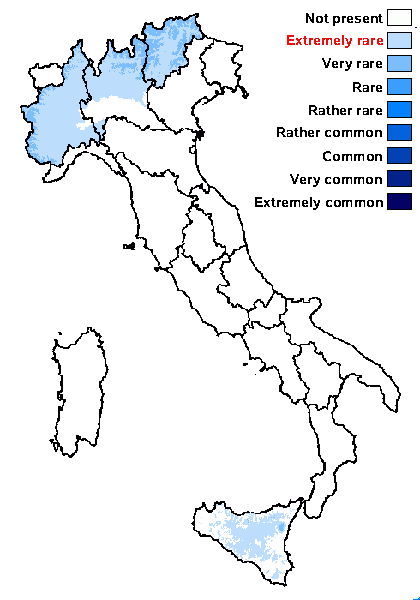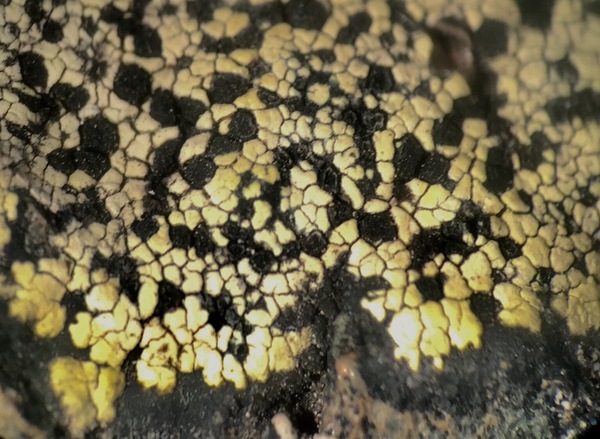Rhizocarpon geographicum subsp. diabasicum (Räsänen) Poelt & Vězda
in Hawksworth & al., Lichenologist, 12: 107, 1980. Basionym: Rhizocarpon diabasicum Räsänen - Ann. Bot. Soc. Zool.-Bot. Fenn. Vanamo, 19: 9, 1944.
Synonyms: Rhizocarpon amphiboliticum Räsänen; Rhizocarpon havaasii Räsänen; Rhizocarpon tinei subsp diabasicum (Räsänen) Runemark
Distribution: N - TAA (Nascimbene & al. 2022), Lomb, Piem (Gheza & Nascimbene 2024). S - Si.
Description: Thallus crustose, bright yellow-green, areolate, forming patches 2-12 cm in diam., delimited by a black prothallus which is often visible also as a hypothallus between areoles. Areoles angular, 0.6-2 mm wide, contiguous, flat to slightly convex, smooth, epruinose. Cortex without distinct structure; medulla white, I+ blue. Apothecia frequent, lecideine, arising between the areoles, round to angular, 0.5-1.5 mm across, with a black, flat to weakly convex, epruinose disc, and a thin, finally often excluded proper margin. Proper exciple pale brown to brownish red; epithecium reddish brown to reddish violet, K+ distinctly red; hymenium 140-180 µm thick, colourless to greenish, K/I+blue, K+ greenish; paraphysoids strongly conglutinate, richly branched and anastomosing, clavate; hypothecium dark brown, K-. Asci 8-spored, clavate, fissitunicate, with a well-developed tholus, lacking an ocular chamber, Rhizocarpon-type. Ascospores muriform, with many septa, soon becoming dark green to brown, ellipsoid, 28-40 x 12-16 µm, halonate. Photobiont chlorococcoid. Spot tests: medulla K-, C-, KC-, P+ yellow. Chemistry: cortex with rhizocarpic acid; medulla with psoromic acid. Note: on siliceous rocks, sometimes also on superficially decalcified calcareous rocks, where it appears in forms with a whitish thallus, near and above treeline.
Growth form: Crustose
Substrata: rocks
Photobiont: green algae other than Trentepohlia
Reproductive strategy: mainly sexual
Commonnes-rarity: (info)
Alpine belt: very rare
Subalpine belt: very rare
Oromediterranean belt: very rare
Montane belt: extremely rare
Submediterranean belt: extremely rare
Padanian area: absent
Humid submediterranean belt: absent
Humid mediterranean belt: absent
Dry mediterranean belt: absent

Predictive model
Growth form: Crustose
Substrata: rocks
Photobiont: green algae other than Trentepohlia
Reproductive strategy: mainly sexual
Commonnes-rarity: (info)
Alpine belt: very rare
Subalpine belt: very rare
Oromediterranean belt: very rare
Montane belt: extremely rare
Submediterranean belt: extremely rare
Padanian area: absent
Humid submediterranean belt: absent
Humid mediterranean belt: absent
Dry mediterranean belt: absent

Predictive model
 Index Fungorum
Index Fungorum
 GBIF
GBIF




